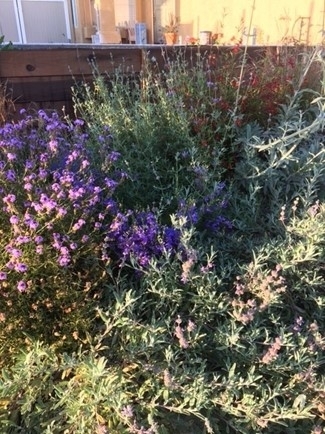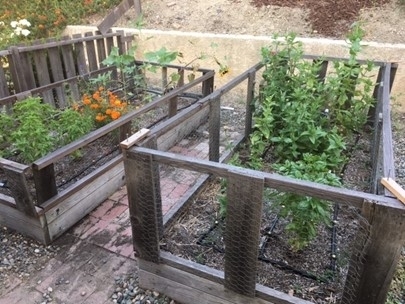In today's world, we have too much information, too much pressure, and too much to do. Many people would like to contribute to their community. Still, they cannot find time in their busy schedules to volunteer. When UC San Bernardino County Master Gardener Michael Bains first became a Master Gardener in 2017, he wanted to volunteer. He was unsure how he could find the time while working full-time and raising two young children with his wife.
His love for gardening and passion for the UC Master Gardener program inspired him to find creative ways to manage his time to contribute to the Master Gardener program. He saw a need for volunteers to work on the UC San Bernardino County Master Gardener helpline and thought it would be interesting to learn more about it. Michael realized he could research callers' gardening questions and provide answers on his lunch hour or after hours while home with his family. So, he thought he would give it a try. That one small step evolved into Michael's providing consistent helpline support to the local community for several years.
Michael enjoys interacting with the people who contact the helpline. Everyone he has met through the helpline has been appreciative of the information provided by all the volunteers. He says it is a good feeling knowing that he has helped other gardeners. Callers realize the helpline's value delivering research-based and practical gardening and horticulture answers to their questions. San Bernardino County residents are invited to contact Michael and his fellow helpline colleagues with their gardening questions via telephone (909.387-2182) or email mgsanbern@ucanr.edu. Please leave a message with your name and contact information along with specific information about your gardening or landscaping question(s).
Michael learned through the UC Master Gardener program how easy gardening can be. In the class on fruit trees, he learned about the variety of fruit trees grown in San Bernardino and that many trees can be espaliered. Michael had a property section at his house where he wanted to create more privacy from his neighbors. He decided that a couple of espaliered apple trees might multi-task as a privacy screen and provide fruit for his family's consumption. Michael says the process for espaliering trees is not complicated and that anyone can do it. His first step in the process was to embed three posts in the ground 8 feet apart. In step 2, he ran a metal wire across the posts at 18 inches and 36 inches above the ground. Step 3, he planted the apple trees between the posts. Step 4, he attached individual branches of each of the trees to the nearest wire. As each tree branch grows, he continues the process of connecting limbs to the closest wire. Michael enjoyed his first experience with espaliering trees so much that he is espaliering some peach and nectarine trees in his front yard. What Michael likes best about the UC Master Gardener program are the people he meets.
He says that gardeners are some of the nicest people he has ever met and that he has “never met a grumpy gardener.” UC Master Gardeners are just a further example of that! If you are interested in becoming a UC Master Gardener, Michael encourages you “to go for it!” The 3-month research-based UC Master Gardening training takes time; however, it is rewarding. You will learn a lot about home horticulture, pest management, and sustainable landscape practices. (While the current class is full, if you are interested in next year's class, please leave your contact information with the MG helpline to receive information when the application process opens again).
Michael developed an interest in gardening when he took a vegetable class in 2015 at the Loma Linda Library. He learned a lot about vegetables and realized that he enjoyed gardening. At the time, he thought, "Hey, I can do this!" Taking the vegetable class helped him grow a vegetable garden in his side yard. His gardening interests have taken off from there.
Michael's Native Plants Garden
In learning about sustainable gardening and the importance of native and well-adapted non-native plants, Michael and his wife developed a strong desire to remove the lawn at their home and replace it with native plants. In 2017 he took out the family's front yard. I have heard many different approaches to taking out a lawn, from simple steps to more labor-intensive methods. Michael was so motivated to replace his yard with native plants that he removed it the old-fashioned way with a shovel and hours of backbreaking labor. Michael has been a member for several years of the Rancho Santa Ana Botanic Garden (RSABG), now known as the California Botanic Garden in Claremont. He has always enjoyed and appreciated native plants but thinks people sometimes do not fully appreciate them. They see native plants in their natural, wild habitat during the hot summer months when their beauty might not be at their peak. Michael decided he wanted to demonstrate that native plants can be an attractive addition to gardens in all seasons with some TLC, and they are easy to grow. Michael did not need to use any soil amendments; “you just plop them in the ground” and let them grow. Michael posted an excellent article on the UC ANR website about using native plants https://ucanr.edu/blogs/blogcore/postdetail.cfm?postnum=24031.
He replaced one side of the yard with an olive tree and under plantings. He created a courtyard with native plants on the other side of the yard leading to the front door. Michael says it takes work (removal of whatever was there, adding irrigation, mulching) to start a native plant garden. Still, it is a good feeling of accomplishment! In April 2017, Michael decided to transition one of his raised bed vegetable gardens to a cut flower garden.
Michael's Cut Flower Garden
His decision to transition was because he fought a losing a battle with the “Squirrel Hoards of Chino Hills.” Michael found the transition easy because vegetable gardens and cut flower gardens require the same things - rich, loose soil, fertilizer, and regular watering. Be sure to read Michael's helpful article on the transition he made https://ucanr.edu/blogs/blogcore/postdetail.cfm?postnum=25189.
Michael likes to use drip irrigation systems in his garden. He has converted nearly all his yard to it. Michael has practical advice to anyone interested in converting to a drip irrigation system. Use a drip line and prepare a grid system to cover the whole bed. Don't use a drip line that you will need to punch into and then add emitters. As the plants grow, you will need to move the individual emitters further from the plant. You will also have to go to the trouble of adding more emitters when you plant a new plant. They also seem to break more often. Michael enjoys container gardening as well as in-ground gardening. He likes to grow plants that do not do well in Chino Hills' heavy clay soil in containers. He has dahlias growing in containers this year with an underplanting of pansies, basil, mint, parsley, tea roses, and some clipped boxwood. Michael has a tip for gardeners who are interested in container gardening. The rabbits and squirrels eat those plants too, so be prepared to keep the critters out. They can reach higher than you think.
The UC San Bernardino County Master Gardeners are thankful for Michel's dedication to the helpline. He has extensive practical gardening knowledge that he shares with anyone who contacts the helpline. He also shows us how we can manage our time effectively to fit volunteer activities into our busy lives!

